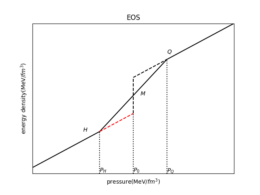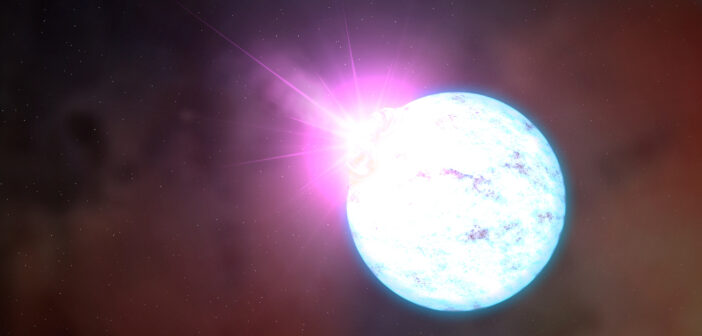Editor’s Note: Astrobites is a graduate-student-run organization that digests astrophysical literature for undergraduate students. As part of the partnership between the AAS and astrobites, we occasionally repost astrobites content here at AAS Nova. We hope you enjoy this post from astrobites; the original can be viewed at astrobites.org.
Title: Neutron Star Phase Transition as the Origin for the Fast Radio Bursts and Soft Gamma-ray Repeaters of SGR J1935+2154
Authors: Jun-Yi Shen et al.
First Author’s Institution: Huazhong University of Science and Technology
Status: Published in ApJ
Astronomers are infamously bad at naming things. So when we observed unexplained quick radio pulses in 2007, we imaginatively dubbed them fast radio bursts (FRBs). However, a name does not a physical theory make: the exact cause of these FRBs is still unknown. FRBs are bonkers energetic, putting out as much energy in about a millisecond as the Sun does in three days. The huge energy involved likely implies that FRBs originate from the most extreme objects or events in our universe, such as neutron stars, black holes, and supernovae. Also, some FRBs repeat their bursts, but these repetitions are not evenly spaced in time. This rules out cataclysmic one-time events such as mergers or supernovae, while their uneven spacing is confusing as orbital events have a regular period.

Figure 1: An artist’s impression of a magnetar, a neutron star with an extremely strong magnetic field and possible source of fast radio bursts. [ESO/L. Calçada; CC BY 4.0]
Neutron Star Anatomy Crash Course
To understand the cores of neutron stars we first have to understand quarks. You may have heard of quarks — protons and neutrons are each made of three quarks — and we call any particle made up of quarks a hadron. In fact, we have never observed quarks outside a hadron due to a phenomenon called quark confinement. (A proof of quark confinement is one of the millennium prizes in mathematics, so if you think you have it, you should collect your one million dollars!) However, in extreme enough environments, hadrons “melt” into a quark–gluon plasma (QGP), affectionately referred to as quark–gluon soup. Delicious! In the plasma, quarks are freed from their enforced trios and can travel unconfined. As you might have guessed given the topic of this bite, it is hypothesized that the extreme density at the core of neutron stars may be enough to create QGP. However, at the surface of the neutron star, called the crust, the energy densities are too low for this plasma to exist, and all of the quarks are locked up in neutrons. Hence, there must be some transition point between the hadronic phase (the neutrons) and the quark phase (QGP) within the neutron star.
Phase Transitions
A phase transition is when the state of matter changes, such as liquid water freezing or boiling away. The authors predict that a phase transition in the magnetar could cause FRBs. To show this, they need a neutron star’s equation of state, which describes how its pressure is related to its density. Finding the equation of state of a neutron star is an area of active research, so the authors use a combination of many articles working on the problem to give expressions for the equation of state of the outer hadronic crust and the gooey quark soup center.

Figure 2: The model of neutron star equation of state used by the authors. H, M, and Q stand for the hadronic, mixed, and quark regimes, respectively. The red line represents the metastable hadronic state. When the neutron star undergoes the sudden phase transition at a pressure around p, the matter jumps from the red line to the normal mixed regime line, causing the star to shrink and theoretically generating an FRB. [Shen et al. 2023]
The authors hypothesize that some of the hadronic matter will start in the metastable state, but as the neutron star’s spin slows down over the course of its life, the pressure will increase in the core and cause the hadronic matter to fully convert to quark matter (see Figure 2). This change to the denser phase would cause the star to suddenly shrink in size, and the lost gravitational potential energy would be released as an FRB. Could this be enough energy to power the FRBs we observe?
Modeling the Collapse
To find out, the authors solve the Tolman–Oppenheimer–Volkoff equation — yes, that Oppenheimer with the new movie coming out, though unfortunately trailers imply it’s not about his contributions to astrophysics — which describes a rotating sphere of material in gravitational equilibrium in general relativity, an excellent model of a neutron star. The authors use the equation to calculate the energy released by the neutron star as it shrinks under the phase shift for a variety of possible equations of state and models of the mixing region. They find that for an appropriate choice of the equation of state, the energy released by the phase transition would be enough to power SGR 1935+2154, and the energy release would occur roughly often enough to explain observations of repeated bursts! The authors also note that the star would only shrink by about a micrometer, and yet the system is so extremely dense that this is enough to release the energy required.
In addition, this rapid shift in radius would cause a starquake called a glitch, where the magnetar suddenly increases its spin thanks to conservation of angular momentum. Their model predicts a glitch size that is comparable to glitches observed in SGR 1935+2154. In addition, neutron stars have been observed to undergo seemingly random decreases in their spin, called anti-glitches. Since the exact timing of the transition in this model is dependent on the spin of the neutron star, this could explain the variability in the period of FRBs.
While these results are exciting, there are many hurdles to overcome. For instance, the authors note that while the energy scales match, they do not yet have a proposed mechanism for how this energy actually becomes radiation in the form of a radio pulse, while other models do. Nevertheless, the authors highlight that future gravitational wave observations of an FRB would be an excellent way of testing their model, as their use of a general relativistic model of an FRB would allow them to directly predict the type of gravitational wave we see. Thus, while the mystery may be unresolved, the hunt to understand FRBs will push us to understand the most extreme environments in our universe and unite disparate areas of physics and astrophysics.
Original astrobite edited by Pranav Satheesh.
About the author, Cole Meldorf:
I am a Master’s student at the University of Cambridge, currently studying a bit of both observational and theoretical cosmology, particularly in the avenue of using machine learning methods and cosmological data to constrain cosmological parameters. I also do some research with the Dark Energy Survey on galaxy evolution and supernova cosmology. When I’m not dying under the crushing weight of finals and PhD applications, I play the violin, do a little theater, and like to cook!

